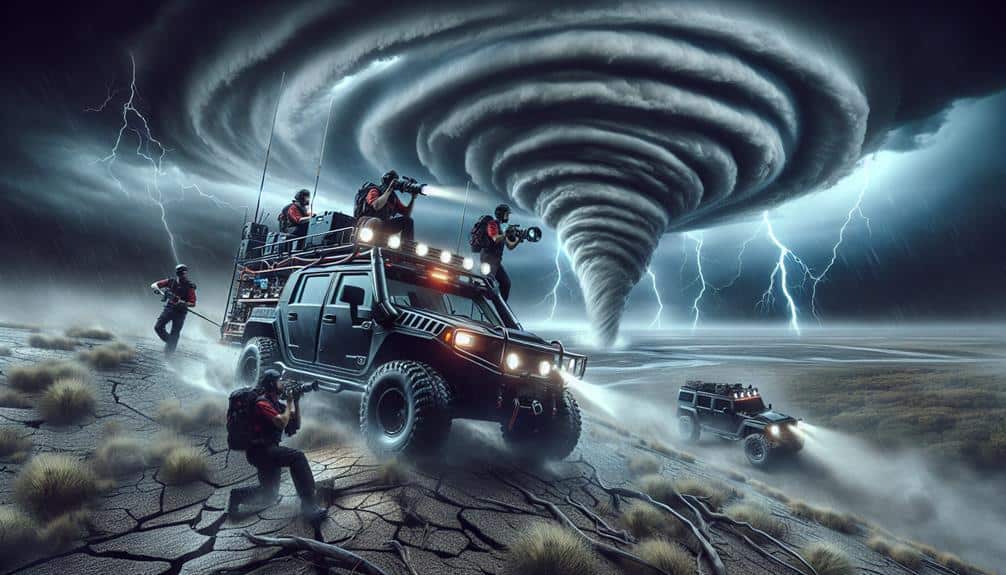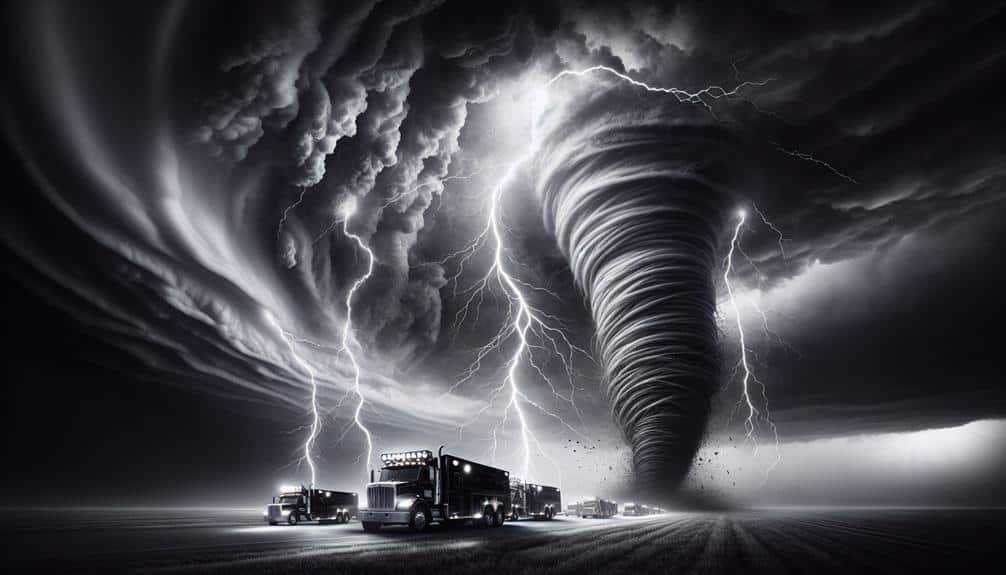We grasp that real-time storm alerts are vital for dedicated storm chasers. Utilizing advanced weather radars like Doppler, GPS, and mapping software, we can make swift decisions during storm tracking. Alerts from apps like RadarScope and Storm Shield provide highly accurate data essential for our safety and precise data collection. Monitoring real-time wind patterns and atmospheric conditions helps us forecast storm movements and enhance tracking strategies. Efficient communication systems guarantee team coordination and safety protocols. By integrating these tools and techniques, we optimize both our safety and the quality of our storm chasing data. Stay tuned to delve into these methods further.
Key Points
- RadarScope offers high-definition radar data essential for predicting storm trajectories in real-time.
- Storm Shield provides reliable push notifications integrated with National Weather Service alerts for timely warnings.
- MyRadar features a user-friendly interface with real-time flight tracking to enhance storm chasing accuracy.
- Advanced Weather Radars like Doppler are crucial for obtaining real-time, precise storm data.
Importance of Real-Time Alerts
In storm chasing, real-time alerts are essential for ensuring safety, optimizing tracking strategies, and maximizing data collection accuracy. When we're out in the field, every second counts. Timeliness of alerts allows us to make rapid decisions about our positioning relative to the storm, reducing the risk of unexpected weather phenomena.
For instance, if a tornado forms suddenly, a real-time alert can provide us with critical seconds to reposition or take cover.
Accuracy in these alerts is equally vital. High precision in storm data enables us to focus our efforts on the most promising weather cells, thereby improving our tracking strategies. Accurate alerts help us determine the exact location, velocity, and potential path of the storm, giving us the freedom to choose the best observational vantage points.
This precision not only enhances our safety but also bolsters the quality of our data collection.
Essential Tools for Storm Chasers
To effectively monitor and study extreme weather, storm chasers rely on a suite of essential tools that enhance safety, data accuracy, and operational efficiency. Proper equipment preparation and robust communication strategies are pivotal for successful storm chasing. We need to guarantee our gear is ready and reliable before heading into the field. This includes everything from weather radar applications to high-definition cameras.
- Advanced Weather Radars: These provide us with real-time data on storm movements, intensity, and potential hazards. Radars like Doppler are indispensable for precise tracking.
- GPS and Mapping Software: Accurate route planning is vital. GPS devices and mapping software help us navigate safely and avoid dangerous areas while ensuring we're in the best position to observe and collect data.
- Communication Devices: Reliable communication strategies, including satellite phones and two-way radios, are essential. These tools guarantee we stay connected with our team and emergency services, enhancing our safety.
- Emergency Kits: In-depth emergency protocols demand well-stocked kits. These should include first aid supplies, extra batteries, and survival gear to address any unforeseen situations.
Top Alert Systems to Use
Effective storm chasing hinges on leveraging top-tier alert systems that provide real-time, accurate warnings of impending severe weather events. We must scrutinize the alert system comparison and user experience to make informed choices.
Among the top contenders are storm tracking apps like RadarScope, Storm Shield, and MyRadar, each exhibiting varied accuracy levels.
RadarScope excels with its high-definition radar data, offering granular details essential for predicting storm trajectories. Its user experience is streamlined, allowing us to quickly interpret data and make timely decisions.
Storm Shield, on the other hand, provides reliable push notifications and integrates seamlessly with National Weather Service (NWS) alerts, ensuring we're always up-to-date on severe weather advisories.
MyRadar stands out with its user-friendly interface and real-time flight tracking capabilities, making it invaluable for tracking storm movement across large areas. Its accuracy levels are remarkable, often matching professional meteorological data, giving us the freedom to navigate safely and efficiently.
In comparing these alert systems, we find that each has unique strengths that cater to different aspects of storm chasing. By understanding their capabilities and limitations, we can select the best tools to enhance our storm chasing endeavors, ensuring we remain both informed and agile.
Interpreting Weather Data Quickly
Quickly interpreting weather data is vital for storm chasers, demanding mastery of radar imagery, wind patterns, and atmospheric conditions. As storm chasers, our ability to make timely, data-driven decisions can mean the difference between witnessing a powerful storm and missing it entirely.
Effective data analysis involves several key components:
- Radar Imagery: We need to understand the different types of radar data, such as reflectivity and velocity, and how to interpret them to identify storm structures and potential tornado formations.
- Wind Patterns: Monitoring wind direction and speed at various altitudes helps us predict storm movement and intensity. Wind shear, in particular, is critical for identifying rotating supercells.
- Atmospheric Conditions: Parameters like temperature, humidity, and dew point provide insight into the storm's potential severity and lifecycle.
- Model Forecasts: Utilizing numerical weather prediction models allows us to forecast weather patterns and plan our chase routes with greater precision.
Staying Safe During Storm Chase

Securing our safety during a storm chase necessitates a detailed strategy grounded in real-time data analysis and situational awareness. We must prioritize safety precautions, including monitoring atmospheric conditions continuously and having a well-defined emergency response protocol.
Utilizing advanced radar systems and satellite imagery, we can predict severe weather patterns accurately and adjust our course proactively to avoid hazardous areas.
Effective communication strategies are vital. We employ reliable, redundant communication systems to guarantee constant contact within our team and with external meteorological agencies. This includes using two-way radios, satellite phones, and mobile applications designed for storm chasers. Regular check-ins and updates ensure that everyone is informed about any sudden changes in storm dynamics.
Team coordination is essential for a successful and safe storm chase. We designate specific roles, such as a lead navigator, a data analyst, and a safety officer, to streamline operations and enhance decision-making efficiency. Each member's expertise contributes to a thorough understanding of the evolving storm, allowing us to make informed, collective decisions swiftly.
Frequently Asked Questions
How Can I Get Involved With a Storm Chasing Community or Network?
We can ease into the storm chasing community by joining online forums and local groups. Let's share knowledge on chasing techniques and safety protocols. Our collective experience guarantees we pursue our passion while staying out of harm's way.
What Qualifications or Training Are Recommended for Beginner Storm Chasers?
For beginner storm chasers, we recommend understanding meteorology basics, including weather patterns and storm formation. Adhering to safety protocols is essential to minimize risks and guarantee informed decision-making during pursuits. Proper training guarantees both safety and data accuracy.
Are There Specific Regions Best Suited for Storm Chasing Activities?
We prioritize ideal locations in Tornado Alley due to consistent storm patterns. By conducting thorough risk assessments and implementing stringent safety precautions, we balance the thrill of chasing with our commitment to safety and data-driven decision-making.
How Do Storm Chasers Communicate and Coordinate During a Chase?
During a chase, we communicate and coordinate like a hive of bees, using radios and GPS for real-time updates. Following strict safety protocols and emergency procedures guarantees we stay safe while pursuing our passion.
What Are the Legal Considerations for Storm Chasing in Different States?
When considering storm chasing, we must evaluate liability risks and permit requirements, which differ by state. It's important to research specific regulations and obtain necessary permits to mitigate legal issues while ensuring our freedom to chase storms responsibly.

